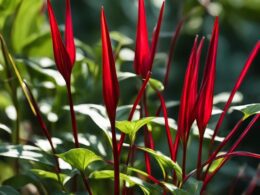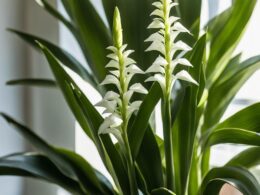Have you ever heard of a flower that takes 40 years to bloom? Sounds like an eternity, doesn’t it?
Well, the Agave plant is one of the few plants that takes that long to flower. This succulent plant is native to Mexico and the southwestern United States, and it has been cultivated for thousands of years for its medicinal and nutritional properties.
The Agave plant is not just any ordinary plant. It is a plant with a fascinating life cycle that involves a 40-year wait for its one and only bloom. That’s right, this plant takes four decades to produce a single flower.
While waiting for this momentous event, the Agave plant will grow to be quite large and impressive, with some species reaching up to 30 feet tall. The Agave plant is a symbol of patience and resilience, and it has been revered by cultures around the world for centuries.
In this article, we will explore the life cycle of the Agave plant, its importance, and how to cultivate and care for it.
Introduction to the Agave Plant
You might be surprised to learn that the agave plant, a succulent native to Mexico, can take up to four decades to produce its towering flower stalk. However, this long wait is worth it because the agave plant has many uses.
For centuries, agave has been used to make tequila and mezcal, two of Mexico’s most popular alcoholic beverages. Additionally, agave nectar, a sweetener, has become increasingly popular in recent years as a natural alternative to sugar.
Apart from its culinary uses, the agave plant also has medicinal properties. The sap of the agave plant has been used to treat burns, wounds, and other skin conditions. It has also been used to treat digestive issues, such as constipation and diarrhea. The sap contains a compound called saponin, which has anti-inflammatory and antimicrobial properties.
In conclusion, the agave plant may take up to 40 years to bloom, but its uses are numerous. From tequila to medicinal remedies, the agave plant has played an essential role in Mexican culture for centuries. So, the next time you enjoy a margarita or use agave nectar in your coffee, remember the long wait that went into producing it.
What Plant Takes 20 Years to Grow?
The Bristlecone pine is a remarkable example of what takes 20 years to grow. This resilient tree can take up to two decades to reach just a few inches tall. Despite its slow growth, it can live for thousands of years and thrives in harsh environments, making it a symbol of endurance and patience in the botanical world.
The 40-Year Blooming Cycle
You may be wondering what factors affect the blooming cycle of the Agave plant. Well, the answer lies in various environmental conditions such as temperature, rainfall, and soil quality.
When the plant finally blooms, it produces a magnificent flower stalk that can reach up to 30 feet tall. This event marks the end of the plant’s life cycle as it dies soon after.
However, the plant leaves behind thousands of seeds, ensuring its species’ survival for generations to come.
Factors Affecting the Bloom
Discovering what affects the blooming process of a flower can be fascinating and may surprise you! One of the main factors that affect the blooming process of a flower is the quality of the soil. If the soil isn’t rich enough in nutrients, the flower may not be able to bloom properly.
In addition, the pH level of the soil can also affect the blooming process. Some flowers require a specific pH level to bloom, so it’s important to make sure the soil is at the correct level.
Another factor that can affect the blooming process of a flower is the climate conditions. Different flowers require different climate conditions to bloom. For example, some flowers require a hot and dry climate, while others require a cool and moist climate.
Temperature, humidity, and sunlight are important factors that can affect the blooming process of a flower. It’s important to research the specific flower you’re growing to ensure you’re providing the correct climate conditions for it to bloom properly.
By taking these factors into consideration, you can help your flower bloom successfully.
Magnificent Flower Stalk
The Magnificent Flower Stalk of the agave plant is a true testament to the longevity of nature’s design. This incredible plant is known to take up to 40 years to bloom, making it a rare sight to behold.
The agave plant is a symbol of cultural significance in many parts of the world, often representing strength and resilience.
As you gaze upon the towering flower stalk of the agave plant, you can’t help but feel a sense of awe and wonder. The sheer size and beauty of the bloom is a reminder of the power of nature and the incredible things it can create.
The longevity of the agave plant is a testament to its ability to withstand the test of time, and the cultural significance it holds only adds to its magnificence.
Thousands of Seeds Produced
You’ll be amazed to know that the agave plant produces thousands of seeds, showcasing its incredible ability to propagate and survive in harsh conditions.
These seeds are produced after the plant has bloomed, and they are an essential part of the plant’s life cycle.
Seed germination is the process by which these seeds grow into new plants, and the agave is known for its impressive success rate. It’s said that one agave plant can produce up to a million seeds in its lifetime, ensuring that its species will continue to thrive for many years to come.
Plant propagation is essential for the survival of any species, and the agave’s ability to produce so many seeds is a testament to its resilience. These seeds are dispersed by the wind, and once they land on fertile soil, they begin to grow into new plants.
The agave’s incredible ability to propagate ensures that it will continue to thrive for generations to come. So, the next time you see an agave plant, take a moment to appreciate its incredible ability to produce thousands of seeds and ensure the survival of its species.
Importance of the Agave Plant
The Agave plant is truly remarkable, with its ability to survive harsh conditions and produce a sweet nectar used in tequila production. It’s no wonder that this plant has played an important role in both cultural and economic aspects of society.
The uses of the agave plant are endless, from medicinal purposes to fiber production. In fact, the agave plant has been used for thousands of years by indigenous peoples in Mexico, who recognized its value long before it became popular in the Western world.
The cultural significance of the agave plant cannot be overstated. In Mexico, the agave plant is often referred to as ‘the tree of life’ due to its ability to provide sustenance in harsh desert environments. It is also a symbol of national pride, as tequila is a beloved Mexican spirit enjoyed around the world.
But beyond its cultural significance, the agave plant also has important economic benefits. The tequila industry alone is worth billions of dollars, providing jobs and income for countless individuals.
In short, the agave plant is an incredibly important and versatile plant that has played a significant role in both cultural and economic aspects of society. It’s no wonder that this plant has been revered for thousands of years, and continues to be an important part of Mexican culture today.
So next time you enjoy a sip of tequila, take a moment to appreciate the remarkable plant that made it all possible.
Cultivation and Care
To successfully cultivate and care for your own agave plant, you’ll need to pay close attention to its unique needs.
Agave plants require well-draining soil, so make sure to use a mixture of sand, gravel, and perlite to ensure proper drainage. Additionally, agaves prefer to be in full sunlight, so make sure to place it in an area where it can get at least six hours of sun per day.
When it comes to watering your agave plant, it’s important to keep in mind that agaves are native to arid regions and can survive long periods of drought. Water your agave plant sparingly, allowing the soil to dry out completely between watering sessions. Overwatering can cause root rot and other issues, so it’s better to err on the side of underwatering.
If you live in an area with harsh winters, it’s best to bring your agave plant indoors or cover it with a protective blanket to prevent damage from frost.
With the right soil requirements and watering techniques, your agave plant can thrive for many years and eventually bloom a towering flower stalk. So, make sure to give your agave plant the care it needs to reach its full potential.
Conclusion
Now that you’ve learned about cultivating and caring for your agave plant, it’s time to put your green thumb to the test and watch as your plant grows and thrives under your care. Remember, it’s important to give your agave plant plenty of sunlight, well-draining soil, and to water it sparingly. With patience and perseverance, you’ll soon start to see your plant flourish before your eyes.
When it comes to caring for your agave plant, it’s important to keep in mind the long-term benefits. While it may take up to 40 years for your agave plant to bloom, the wait is well worth it. Not only will you be rewarded with a stunning display of flowers, but your plant will continue to thrive for years to come. By taking the time to properly care for your agave plant, you’ll be investing in a beautiful addition to your home or garden.
Remember, cultivating and caring for your agave plant requires patience and perseverance. While it may take some time for your plant to grow and bloom, the end result is well worth the wait. By following the proper care instructions and giving your plant the attention it deserves, you’ll be able to watch as it flourishes and becomes a beautiful addition to your home or garden. So don’t be discouraged if you don’t see immediate results – keep at it, and you’ll soon see the long-term benefits of your hard work.
Frequently Asked Questions
Are there any other plants that have blooming cycles as long as 40 years?
The natural world is full of surprises, and some plants have blooming cycles that are truly remarkable. The longest blooming plants can take decades to show off their flowers, and their unusual blooming cycles are a testament to the incredible diversity of life on Earth.
From the giant saguaro cactus, which can take up to 75 years to bloom, to the century plant, which blooms only once in its lifetime of 10-30 years, these plants are a wonder to behold. It’s fascinating to think about the patience and perseverance that these plants must have to wait so long to bloom.
If you’re looking for a reminder that nature is full of surprises, look no further than these incredible plants with their long and unusual blooming cycles.
Can agave plants be grown indoors?
Looking to grow agave plants indoors? It’s definitely possible, but there are a few things you should know.
First, agave plants thrive in bright, direct sunlight, so you’ll need to make sure your indoor space can accommodate that. You’ll also want to make sure your agave plant has well-draining soil and is watered sparingly.
One of the benefits of indoor agave gardening is that you can enjoy these striking plants year-round, regardless of the weather outside. However, there are also some drawbacks to consider, such as the potential for pests and the fact that indoor agave plants may not grow as large as their outdoor counterparts.
Overall, if you’re up for the challenge, growing agave plants indoors can be a rewarding and visually stunning addition to your home.
How long does it take for an agave plant to reach maturity?
If you’re interested in growing an agave plant, you might be wondering how long it takes for it to mature. The timeline can vary depending on the species, but most agaves take anywhere from 5 to 15 years to reach maturity.
Some species, however, can take up to 25 years or more. To help your agave plant reach maturity faster, it’s important to use proper cultivation techniques. This includes providing adequate sunlight, well-draining soil, and occasional fertilization.
With these practices in place, your agave plant will be well on its way to reaching maturity and thriving in your home or garden.
What are some common pests and diseases that affect agave plants?
To keep your agave plant healthy, it’s important to prevent infestations and treat any diseases promptly.
One way to prevent infestation is to regularly inspect your plant for signs of pests such as mealybugs, spider mites, and scale insects. If you do notice an infestation, there are natural remedies you can try before resorting to chemical pesticides.
For example, spraying the plant with a mixture of water and dish soap can help to get rid of mealybugs. Additionally, keeping the plant well-watered and in a sunny location can help to prevent infestations as healthy plants are less vulnerable to pests and diseases.
By taking these preventative measures and using natural remedies when appropriate, you can keep your agave plant thriving for years to come.
Can the sap from agave plants be used for any other purposes besides making tequila?
Looking for alternative uses of agave plants? You might be surprised at the range of possibilities!
The sap from agave plants can be used to make sweeteners, syrups, and even vinegar. These alternative uses are highly sought after, especially given the nutritional benefits of agave sap.
Rich in fructose, agave sap is an excellent substitute for sugar, with a lower glycemic index and a sweeter taste. In fact, agave syrup has become a popular ingredient in many health-conscious diets, including vegan, gluten-free, and raw food diets.
So, the next time you’re looking for a sweetener that’s both healthy and delicious, consider trying agave syrup made from the sap of agave plants.
Conclusion
Congratulations, you’ve learned about the amazing Agave plant! This plant takes 40 years to bloom, making it a rare and special sight.
The Agave plant is important for many reasons, including its use in making tequila and mezcal. If you’re interested in cultivating and caring for Agave plants, remember to give them plenty of sunlight and well-drained soil. Be sure to water them sparingly, as they’re drought-tolerant plants.
With patience and care, you may be lucky enough to witness the beauty of a blooming Agave plant after 40 long years. Keep learning and exploring the wonderful world of plants!








